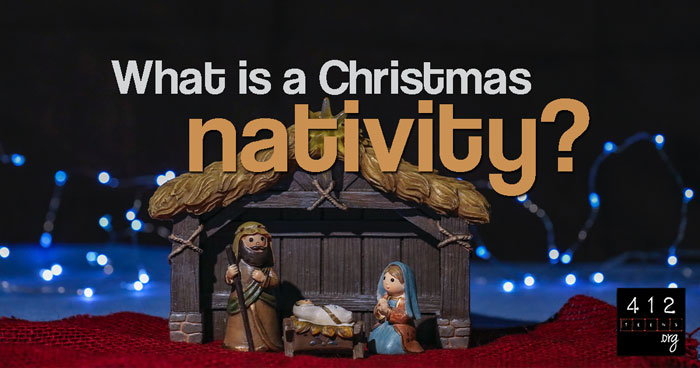What is a Christmas nativity?

"[Mary] gave birth to her firstborn son and wrapped him in swaddling cloths and laid him in a manger, because there was no place for them in the inn." —Luke 2:7
Christmas nativity scenes are a visual depiction of Jesus’ birth into the world as recorded in Matthew 1:18-2:23 and Luke 2:1-20.
Nativity scenes usually consist of some kind of animal stable structure plus figures depicting Mary, Joseph, and baby Jesus. They may be made of different materials, such as wood, plastic, metal, or even inflatables!
There may also be shepherds, animals, three wise men, one or more angels, and a star. In live performances of the nativity, the same elements are included, but they're represented by detailed sets, real people, and live animals.
Where did the Nativity originate?
The word “nativity” is derived from the Latin word nativus, which means "arisen by birth." Tradition says that the first Christmas nativity was created by Francis of Assisi in AD 1223. He had recently gotten back from a trip to the Holy Land, and he was inspired to create a tangible scene to depict Jesus' birth.
This tradition was embraced by Western culture, and today, we see Christmas nativity scenes in front of houses, churches, parks, and in live Christmas pageants. A live Christmas nativity is really fun to see! (My favorite part is seeing the animals—especially those adorable donkeys.)

Is the Christmas Nativity biblically accurate?
Sadly, while Christmas nativity scenes are neat to see, they are not quite biblically accurate. Jesus, Mary, Joseph, "wise men," angels, and shepherds all played a role in the story of Jesus’ arrival in the world, but they were not all together at the same time. And the Bible says nothing about animals or a stable.
The Building
We tend to assume Jesus was born in an animal stable because of tradition and because the Bible tells us that the inn Mary and Joseph inquired at was already full of guests (Luke 2:7). However, the Bible never directly says Jesus was born in a stable—much less one that contained live animals.
The Shepherds & Angels
The shepherds were not there at the exact moment of Jesus’ birth nor were angels flying around when He was born. The shepherds were out tending their flocks of sheep while Mary labored in childbirth, and the angels appeared over the fields where the shepherds were (Luke 2:8-14).
After the shepherds heard the good news of the newborn King's birth, they left their field and went to worship Jesus (Luke 2:16). The Bible doesn't mention any angels with Mary, Joseph, and Jesus.
The Wise Men
While Christmas nativity scenes almost always depict three wise men (or magi), the Bible never provides a number for how many of these "wise men" actually went to find Jesus. It also doesn't indicate that they found the small family right when Jesus was born.
These wise men, no matter how many there were, came much later, after Mary, Joseph, and Jesus were already living in a house (Matthew 2:1-11). Jesus might have been aged anywhere from an infant up to a young toddler by time the wise men arrived.
Should Christians display a Christmas nativity?
There's nothing inherently wrong with having a Christmas nativity as it is a reminder of Jesus’ birth into the world. Even though most nativities are not totally accurate, they can still be an important part of remembering to celebrate Christmas for the right reasons.
The Christmas nativity can remind us that God loves us so much that He sent His Son to become a fragile human baby who would one day die to redeem the sins of the world and restore humankind's relationship with God (John 1:9-14; John 3:16; Romans 5:12).
Our sin has separated us from God, but our great and glorious King entered the world to bring us back to our Heavenly Father. Jesus came "to seek and to save the lost" (Luke 19:10). Jesus truly did seek and save the lost, and He's still at it today.
"[Jesus] gave up his divine privileges; he took the humble position of a slave and was born as a human being. When he appeared in human form, he humbled himself in obedience to God and died a criminal's death on a cross. Therefore, God elevated him to the place of highest honor and gave him the name above all other names, that at the name of Jesus every knee should bow, in heaven and on earth and under the earth, and every tongue declare that Jesus Christ is Lord, to the glory of God the Father." —Philippians 2:7-11
ALSO SEE:
- What is Christmas?
- What is the true meaning of Christmas?
- What is the origin of Christmas?
- Do some Christmas traditions have pagan origins?
- Why is the virgin birth so important?
- What is the meaning of noel?
- Who is Jesus?
- Does the Old Testament predict the coming of Jesus Christ?
- Do the narratives of Jesus' birth contradict each other?
- Was Jesus born on December 25?


TL;DR
The Christmas nativity is a physical depiction of various events which occurred around the time Jesus was born, as recorded in Matthew and Luke. They usually include figures of Mary, Joseph, and a baby Jesus in a manger but may also include an animal stable, wise men, angels, shepherds, and animals. Nativities are often on display in homes or churches. Nativity scenes are not 100% biblically accurate representations of the night of Jesus' birth, but they can still be a great reminder of Jesus’ arrival as the Savior of the world (Luke 2:1-20; John 3:16).

Writer: Vivian Bricker
Vivian loves learning, studying the Word of God, and helping others in their walk with Christ. She is dedicated to helping people learn more about Jesus and is ready to help in any way she can. Her favorite things to do are spending time with her family and friends, cooking, drawing, and spending time outside. When she is not writing, you can find her soaking up the sunshine or going on an adventure.
